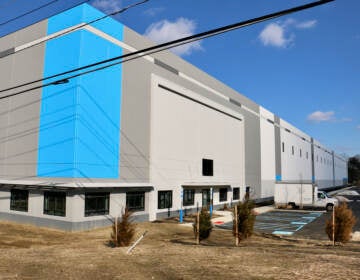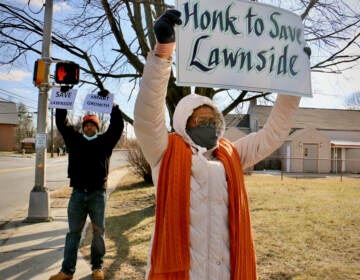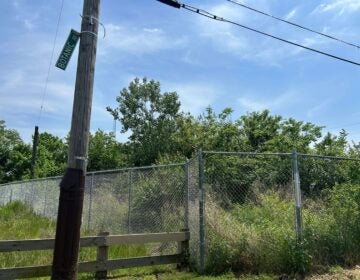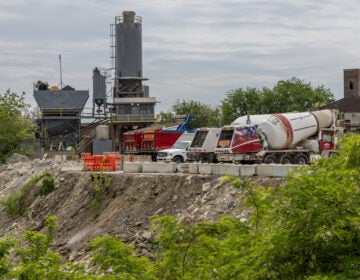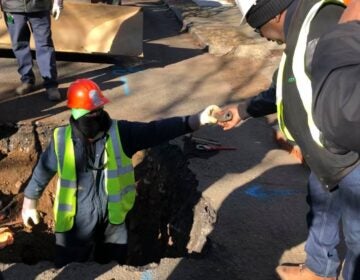Air pollution from New Jersey’s warehouse boom disproportionately impacts communities of color, report finds
Warehouses remain largely unregulated in the state and can be built with little to no environmental review or public scrutiny.
Listen 1:14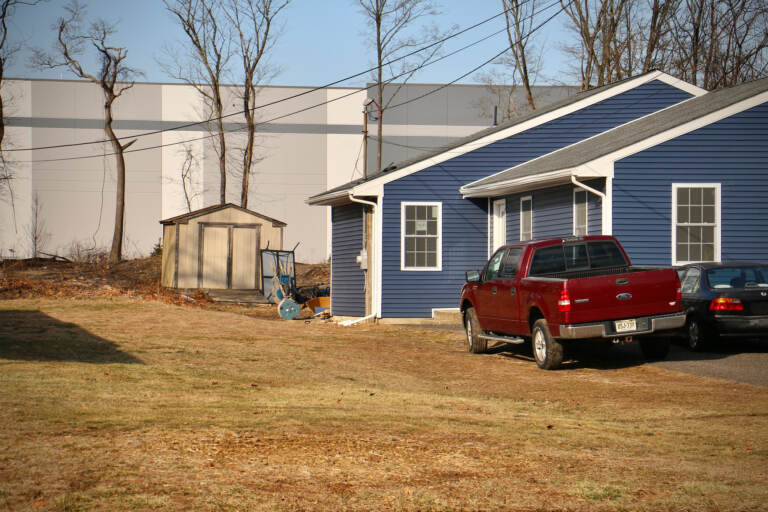
An enormous warehouse looms behind modest homes on East Charleston Avenue in Lawnside, N.J. (Emma Lee/WHYY)
From Camden and Cherry Hill to Trenton and the Jersey Shore, what about life in New Jersey do you want WHYY News to cover? Let us know.
About one in three Garden State residents — 2.7 million people — live within a half-mile of a warehouse larger than a big box retailer, according to a new report from the Environmental Defense Fund on New Jersey’s warehouse boom.
The report also found that so-called mega-warehouses are disproportionately located near communities of color and low-income areas. Those communities also carry the burden of dealing with the effects of pollution from the trucks that transport goods to and from the facilities.
“Each [truck] trip releases harmful pollution, meaning communities near these mega warehouses and the warehouse workers working in these spaces face higher rates of harmful air pollution associated with diseases like premature death, cancer, asthma, COPD and stroke,” said Sam Becker, the report’s author.
Though diesel trucks make up around 11% of vehicles on state roads, they emit 56% of nitrogen oxides, which are precursors to nitrogen dioxide. When mixed with volatile organic chemicals, they create smog. Becker said exposure could exacerbate asthma and other health problems, adding those conditions disproportionately impact children and older people.
“In Hudson, Passaic, Essex and Bergen counties, we have found that NO2 is contributing to more than 13% of new childhood asthma diagnoses every year,” he said. “NO2 across the state is contributing to more than 5300 New childhood asthma cases every year.”
Historian and activist Sue Kozel said she was “horrified” at the statistics for children.
“I have asthma. I don’t wish asthma on anybody,” she said. “I don’t think New Jersey should have children being given the gift of their lungs being compromised by warehouses.“
Low-income and people of color more likely to live within half a mile of a mega-warehouse
Becker said they identified 3,034 warehouses for the report through a private real estate database. More than half of the warehouses — 56% — exceed 100,000 sq. ft. Altogether, the warehouses occupy 527 million square feet, a number that has grown 35% in the last two decades, according to the report.
Low-income households are 1.5 times more likely to live within a half-mile of a mega-warehouse. Those with limited English proficiency are nearly twice as likely.
When categorized by race, Latinos are more likely to live near a warehouse. Though they consist of 20.2% of the state’s population, 36.7% of Latinos are “warehouse neighbors.”
Black populations are 1.4 times more likely to live near a warehouse, while Indigenous Americans are 1.1 times more likely to live near a warehouse.
According to the report, the number of Asians that live near a warehouse is in proportion to the demographic size in New Jersey.
While 70% of the state’s population, whites are 1.2 times less likely to live near a warehouse.
Becker said the location of the warehouses are “due to racist legacies of redlining and other discriminatory policies.”
“Not only are warehouses disproportionately located in these communities, [Latino,] Black, limited English and low-income populations account for large portions of warehouse workers, meaning that many of these workers are being exposed to harmful pollution at the workplace and at home,” Becker said.
Legislation aims to bring transparency to warehouses
The report notes that warehouses are not subject to the state’s Environmental Justice Law, which means they are largely unregulated and can be built with little to no environmental review or public scrutiny.
Asw. Andrea Katz (D-Burlington) and state Sen. John McKeon (D-Essex) are proposing a bill that would establish permit requirements for new and existing warehouses, in addition to those wanting to significantly modify their facilities, expand public participation in the permitting process and require “truck-attracting” facilities to reduce their pollution over time “through concrete actions.”
Katz said the legislation “will bring some transparency to where these mega-warehouses are going and how they’re going to impact the community.”
McKeon called the proposal “a natural extension” to the Environmental Justice Law.

Get daily updates from WHYY News!
WHYY is your source for fact-based, in-depth journalism and information. As a nonprofit organization, we rely on financial support from readers like you. Please give today.


